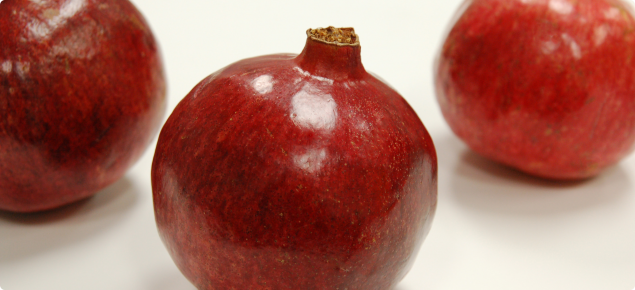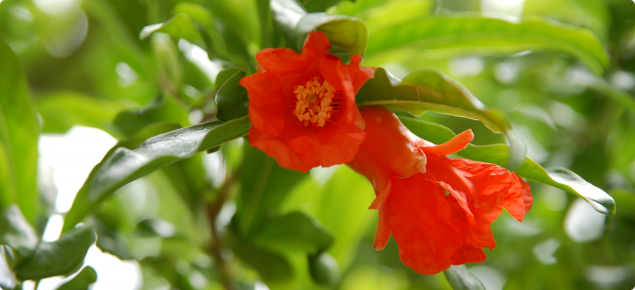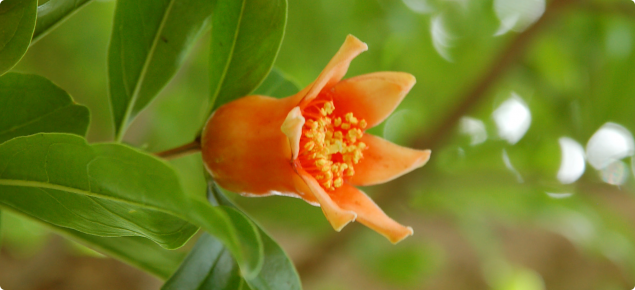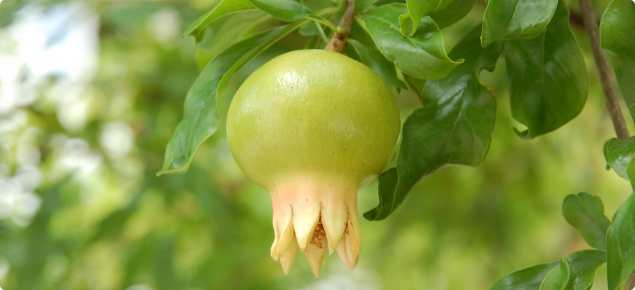Introduction
The round red fruit of pomegranate is a false berry. It consists of many close-packed red grains (arils), and segments which are separated by a non-edible white pith. The arils contain a seed surrounded by an edible juicy pulp.The pomegranate (Punica granatum) is native to Iran through to north India. The main areas of world production are Turkey, Spain and California. The flowers, fruits and autumn foliage are ornamental and it is often planted in home gardens from Carnarvon southward.
At present, the pomegranate is commercially harvested on an insignificant scale in Western Australia. The main annual imports are from California in November and December.
Climate
Pomegranates would probably grow best commercially from Geraldton to Albany. They grow best in warm areas, with temperatures up to 38°C. In inland areas, temperatures can be high and fruits can suffer from sunburn. Rainfall in summer and early autumn should be low. Established plants will survive frosts to minus 10°C. Flowering occurs in late spring, when there are no frosts. Pomegranates do not like high humidity.
Soils
Soils can be variable, but must be well drained.
The pH (by the water system of measurement) should be 5.5 to 7.0, but the plant will grow well in slightly alkaline soils.
Varieties
There are many varieties, with a range of quality varying from very sweet (bland) to very acidic flavours and with soft seeds, medium hard seeds or hard seeds. The best quality pomegranates have a good balance of sugars and acidity, and soft seeds, which can be consumed with the pulp.
Pomegranate varieties were observed at Medina Research Centre in the 1990s. Fruit quality and comments are shown in the table but yields were not recorded.
| Variety | External appearance | Internal appearance/juiciness, acidity | Comments |
|---|---|---|---|
| Gulosha Azerbaijani | Large size, good external appearance (light pink/red skin) | Large red grains, juicy | Good variety |
| Gulosha Rosavaya | Large size, good external appearance (light pink skin) | Large, red grains, juicy | Best variety for combination of sweetness, acidity and external appearance |
| Wonderful | Medium size, claret red skin | More acidic than Gulosha Rosavaya, red grains | Next best to Gulosha varieties, but smaller and more acidic, most common variety in California, better for juicing |
| Victorian Giant | Large size, not very attractive skin | Grain is not highly coloured, not juicy, mild flavour | Poor variety |
| Berri | Large size, unattractive skin | Not juicy, too sweet, bland flavour | Poor variety |
| Veles | Medium size, squarish shape, pink-red skin | Juicy, rich flavour, but very acidic | May be suitable for processing |
| Griffith | Large size, claret red skin | Red grains, rich flavour, but slightly too acidic | Fairly good variety |
Planting material
Pomegranates are easily struck in potting mixture in July and early August from 20 to 30cm cuttings when the plants are dormant. Leave the top one to two buds exposed. The cuttings should be 6 to 12mm thick.
A range of varieties is available from Lewis Horticulture, telephone +61 (0)8 8380 9598, Box 798, Virginia, South Australia 5120.
Keep the plants in a sheltered position in a nursery and use a slow release, complete fertiliser. Plant in spring, 13 to 15 months later, when the plants are 60 to 100cm high.




